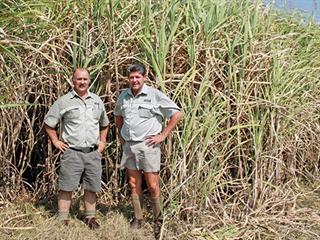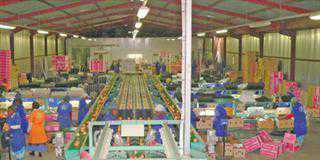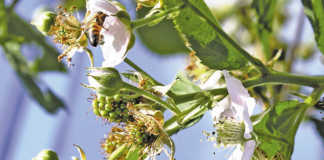
Pongola sugarcane farmer Ernst Holl was about to replant a six-year-old sugarcane land in 2002. “In the Pongola area, we get six to eight ratoons before yield declines to the point that the crop is unprofitable and we have to replant. I wasn’t happy with the fact that on virgin soil, where we usually get higher yields I had to replant after six years,” he recalls.
Ernst thought that if the soil could not sustain better yields for a longer period, conventional farming methods must be failing. A partner in SM Naude Boerdery, which owns the 540ha Nqumile Estates, as well as being chairperson of the Pongola Canegrowers’ Association, he has considerable farming experience. “We grow the same crop every year and remove material from the soil, effectively stripping it,” he explains. “We only focus on NPK (nitrogen, phosphorus and potassium) when we fertilise but there are 16 elements that effect healthy plant growth and soil.”
On the six-year-old irrigated block in question, yield declined from 130 tons cane/ha (tc/ha) at the first cutting in 1997 to
90tc/ ha by the fifth ratoon in 2001, despite generous applications of up to 285kg N/ha. Apart from yield decline, the 78ha block also had a water infiltration problem. Ernst was forced to halve irrigation from the usual 20mm/ cycle to 10mm/cycle to reduce runoff, but this also suppressed growth.
In 2003, biological consultant Ronald Schroder convinced Ernst to run a liming trial based on the DRIS (Diagnosis and Recommendation Integrated System). This identifies imbalances, deficiencies and excesses in crop nutrients and ranks them in order of importance. In this instance, calcium was low and magnesium high. Soils like these invariably lack air- and water-holding capacity, and are costly to work with.
Ernst took a cautious approach, allocating one of the poorly performing N25 variety pivot blocks to the trial. Instead of replanting the cane, the soil was given a once-over. The percentages of calcium and magnesium were corrected by broadcasting 2 000kg/ ha calcitic lime and 1 000kg/ ha gypsum. N applications were cut from 285kg/ ha in 2000 to 170kg/ha.
“Once the desired percentage of calcium is reached, gypsum can be used to improve water-holding capacity. Within six to 12 months of putting down the gypsum, I could apply more water. Yield increased from 92tc/ ha in 2002 to 102tc/ ha in 2003,” says Ernst. In 2005, Ernst decided to use the Albrecht system and called in consultant John Fair. Based on the results of a soil sample, they put down 600kg calcitic lime and 2 200kg gypsum in June 2005.
Yield climbed to 126tc/ ha in 2006, at which point N applications were reduced to 128kg/ha. But the following year, yield dipped off again. “Seeing that we were getting good results with less N, we cut it back to 100kg/ha, but yield decreased to 98tc/ha in 2007. In hindsight, that was a mistake,” he says. In January 2008, N was increased to 118kg/ha and 1 500kg/ha gypsum was applied. But from 2008 to 2011, yields stayed between 100tc/ha and 105tc/ha, even though they had increased N to 130kg N/ha.
“We needed to try something else. The first step of correcting the macro and micro nutrients was completed; the pH was much improved at 7,2, and calcium (71,2%) and magnesium (18,3%) were at the desired levels. But I still wasn’t happy with the yields,” recalls Ernst.
Life in the soil
His next step was to encourage soil life. With the help of SoilTech director Dr Nico van Vuuren, Ernst began improving soil biology with compost tea, using a pre-mix manufactured by SoilTech. The compost tea contains a diverse mixture of good quality compost, fish oil, kelp, molasses and a range of beneficial microbes. It is brewed on the farm under aerated conditions for 18 hours and applied at a rate of 200l/ ha through the irrigation system soon after planting or harvesting, with a second application of 100l/ ha eight weeks’ later.
“Any biological product has the best result on a balanced soil – and it starts with calcium. Calcium plays a huge role in a healthy plant. If there’s a shortage of elements in the soil, there’ll be a shortage of elements in the crop,” says Ernst.
| 2003 | June 2005 | Jan 2008 | Dec 2011 |
| Start with DRIS Apply 2 000kg/ha calcitic lime and 1 000kg/ha gypsum |
600kg calcitic lime | 0kg calcitic lime | 0kg calcitic lime |
| 2 200kg gypsum | 1 500kg gypsum | 0kg gypsum | |
| pH 7,70 | pH 7,4 | pH 7,2 | |
| 57% calcium | 60,7% calcium | 71,2% calcium | |
| 29% magnesium | 26,17% magnesium | 18,3% magnesium | |
| 5,5% sodium | 3,3% sodium |
The yield following the compost tea applications increased dramatically from 105tc/ha in 2011 to 120tc/ha in 2012.
“I expect the 2013 crop will be at least 120tc/ ha, if not bigger,” he says. “We’re back at the yield obtained at first cut, yet the cane is 16 years old – double the age of previous ratoons. The other big plus is that by prolonging the productive life of the crop, we’ve saved the cost of ploughing and establishing new cane, which is about R20 000/ ha. If I can maintain at least 120tc/ha, I’ll probably keep the cane going for as long as possible without replanting.”
Ernst points out that 2012 was a good year in the Pongola valley, with the area’s average sugarcane yield increasing by 10tc/ ha. “Our yield increased by 15t/ha and I attribute about 10t of that to a good rainy season. We need to go another year or two to see if the 2012 yield is sustainable.” According to him, break-even is at 95tc/ ha and even at 105tc/ha the crop is still sufficiently profitable.
No magic bullet
Ernst has been farming biologically for three years and hopes to surpass the current average of six years per crop.
The R6 000/ha that Ernst spent on balancing the soils with lime and gypsum generated a gross income of R50 000/ ha in the 2012 crop alone. Ernst kept his faith in the programme, although the results were not always what he expected. “We had to pioneer the way for biological farming with sugarcane. There was no recipe and I paid for my own mistakes. It’s easier now, although conventional farmers remain critical of these methods.
“The SA Sugar Research Institute does good research but it seems that on the fertiliser side, they’re stuck in their ways. If they’d started running biological trials five years ago, they’d have results by now that prove this right or wrong. We can’t farm without science, but soil biology definitely goes beyond NPK,” he says.
Ernst wants to focus on manufacturing his own compost, using mila from the mill, cow manure and cane tops. He rotates with cash crops, wheat and sun hemp. “Damage has been done to our soils over many years,” he says. “We all look for a silver bullet, but soil correction the biological way takes time. You just have to have the courage to follow through.”
Phone Ernst Holl on 083 263 0711 or email [email protected].
Nico van Vuuren on 072 560 3188 or [email protected].













